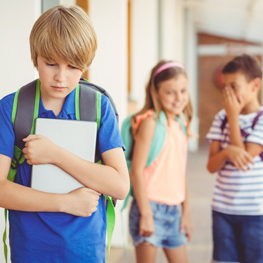
Most of us recall our school days with a mixture of nostalgia and hazy memories. It was a long time ago. We knew bullies and probably had some run-ins with them over the years. In every era there are those children, both boys and girls, who engage in bullying behaviors. Parents walk a fine line when helping their children to deal with bullying behaviors.
What is bullying?
One current definition of bullying is “the use of force or coercion to abuse, intimidate, or dominate others.” It may be habitual behavior to instill fear and may present as verbal harassment and threats, or physical assaults. Bullying can come in many forms: Teasing, name-calling, stealing property, and forcing unwanted acts. Bullying is designed to instill fear and anxiety. Some bullies try to justify their behavior based on the sex, race, class, abilities, or appearance of their victims. When bullying is done by groups, it is known as “mobbing.”
Why? Profile of a bully
It’s hard to understand why children want to hurt others for no apparent reason. Most experts agree that bullies are children who want and need attention. They want to raise their own status by feeling powerful. They often are abused or neglected children who haven’t learned to care about others’ feelings. They are predatory by nature and select their victims as those they perceive as weaker than themselves. They lack a set of values to guide their choices, and rarely accept responsibility for their behaviors. Their behavior can be compulsive and repeated over time. Bullies usually have low self-esteem, insecurities, and fear exposure of their weaknesses. They are driven by bitterness, hatred, anger, and prejudice, which they vent on their victims.
Warning signs
If you suspect that your child is being bullied on the way to school, in school or at other times, here are some behaviors to look for:
In today’s technological world, there are ample opportunities for bullies to act out in the relative anonymity of their computers and phones. They can threaten, expose and tease all the while hiding their identity.
So what can you do?
Parents are often astounded at the intensity of bullying behavior their children tolerate every day. Once a bullying situation is exposed, the offender often changes tactics. The offender stops bullying that particular person for fear of retribution, embarrassment, or consequences. But without help, the offender will most likely bully again. Parents walk a fine line when helping their children to deal with bullying behaviors. If they step in and solve the problem for their child, the child remains vulnerable. If they refrain from acting, they risk their child’s harm, both emotional and physical.
There are common-sense ways to combat bullying:
Proactive teaching - Many schools have anti-bullying campaigns in place. Most often, classroom teachers or school counselors teach these lessons. But change in behavior takes time. Most bullies need one-on-one help to change and, meanwhile, the victims must find ways to stay safe. Parents can do some proactive teaching, too. Talk to your children about staying safe and standing up to bullies. Help your kids build strategies to stand up for themselves, if needed, while never resorting to fighting, which could land them in trouble.
Avoidance techniques - One logical way to stop bullying is to stay away from the bully. If at all possible, your child can change the route taken to school or walk a different hallway to get to their next class. Bullies tend to take advantage of an opportunity. If the opportunity is taken away, they have no victim.
Standing firm - Children need to be proud of themselves and learn to be brave in the face of trouble. For those kids who seem frail or unsure, it’s a good idea to enroll them in classes or join sports programs; get them involved in activities that will help build their self-confidence.
And they need to practice saying a firm “No” to those who bully them and to be willing to ask for help or report problems to authorities. Ignoring threats is sometimes helpful, but having a buddy and being a buddy is probably an even better strategy. The absolute worst choice when being bullied is to tolerate it and to stay quiet. Teach your child to speak up when bullied.
Why not take the opportunity to talk about bullying with your children? What should they do if they witness bullying behavior? And, let’s be honest here, have they ever taken part in bullying another person or witnessed bullying without intervening? Let them know you are always available to talk about uncomfortable situations in their lives. And check out the following websites for more information, strategies, and role-playing activities to give your child the confidence and strength to stand up to bullying behaviors:
According to Public Health Specialist Dr. Alana Vivolo-Kantor, there are three main components to a bullying situation:
An imbalance of power. The bully perceives that they are stronger, smarter, more able to be in charge of a bullying event. The victim is unable to respond in a way to stop the event.
Repetition. A bully thrives on the knowledge that they are in charge. They look forward to the next time they can take advantage of the victim’s weakness.
Aggressive behavior. The bullying event is an aggressive action done on purpose. It may be physical or emotional.
Children at risk to become bullies may have some or all of these characteristics:
Jan Pierce, M.Ed., is a retired teacher, and a freelance writer. She also volunteers in an after-school program for at-risk children.
Calgary’s Child Magazine © 2024 Calgary’s Child